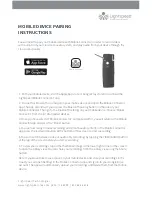
Chapter 7
Troubleshooting Using SMU
205
PHYs are tested and verified before shipment as part of the manufacturing and
qualification process. But subsequent problems can occur in a PHY because of
installation problems such as:
■
A bad cable between enclosures
■
A controller connector that is damaged as a result of attaching a cable and then
torquing the cable connector until solder joints connecting the controller
connector become fatigued or break
Problem PHYs can cause a host or controller to continually rescan drives, which
disrupts I/O or causes I/O errors. I/O errors can result in a failed drive, causing a
virtual disk to become critical or causing complete loss of a virtual disk if more than
one fails.
To avoid these problems, problem PHYs are identified and disabled, if necessary,
and status information is transmitted to the controller so that each action can be
reported in the event log. Problem PHY identification and status information is
reported in SMU, but disabled PHYs are only reported through event messages.
Some PHY errors can be expected when powering on an enclosure, when removing
or inserting a controller, and when connecting or disconnecting an enclosure. An
incompletely connected or disturbed cable might also generate a PHY error. These
errors are usually not significant enough to disable a PHY, so the fault isolation
firmware analyzes the number of errors and the error rate. If errors for a particular
PHY increase at a slow rate, the PHY is usually not disabled. Instead the errors are
accumulated and reported.
On the other hand, bad cables connecting enclosures, damaged controller
connectors, and other physical damage can cause continual errors, which the fault
isolation firmware can often trace to a single problematic PHY. The fault isolation
firmware recognizes the large number and rapid rate of these errors and disables this
PHY without user intervention. This disabling, sometimes referred to as PHY
fencing, eliminates the I/O errors and enables the system to continue operation
without suffering performance degradation.
Once the firmware has disabled a PHY, the only way to enable the PHY again is to
reset the affected controller or power cycle the enclosure. Before doing so, it may be
necessary to replace a defective cable or FRU.
If a PHY becomes disabled, the event log entry helps to determine which enclosure
or enclosures and which controller (or controllers) are affected.
Summary of Contents for StorageWorks 2000fc
Page 16: ...16 HP StorageWorks 2000 Family Modular Smart Array reference guide August 2008 ...
Page 28: ...28 HP StorageWorks 2000 Family Modular Smart Array reference guide August 2008 ...
Page 134: ...134 HP StorageWorks 2000 Family Modular Smart Array reference guide August 2008 ...
Page 148: ...148 HP StorageWorks 2000 Family Modular Smart Array reference guide August 2008 ...
Page 180: ...180 HP StorageWorks 2000 Family Modular Smart Array reference guide August 2008 ...
Page 194: ...194 HP StorageWorks 2000 Family Modular Smart Array reference guide August 2008 ...
Page 226: ...226 HP StorageWorks 2000 Family Modular Smart Array reference guide August 2008 ...
Page 246: ...246 HP StorageWorks 2000 Family Modular Smart Array reference guide August 2008 ...
Page 254: ...254 HP StorageWorks 2000 Family Modular Smart Array reference guide August 2008 ...
Page 318: ...318 HP StorageWorks 2000 Family Modular Smart Array reference guide August 2008 ...
Page 330: ...330 HP StorageWorks 2000 Family Modular Smart Array reference guide August 2008 ...















































